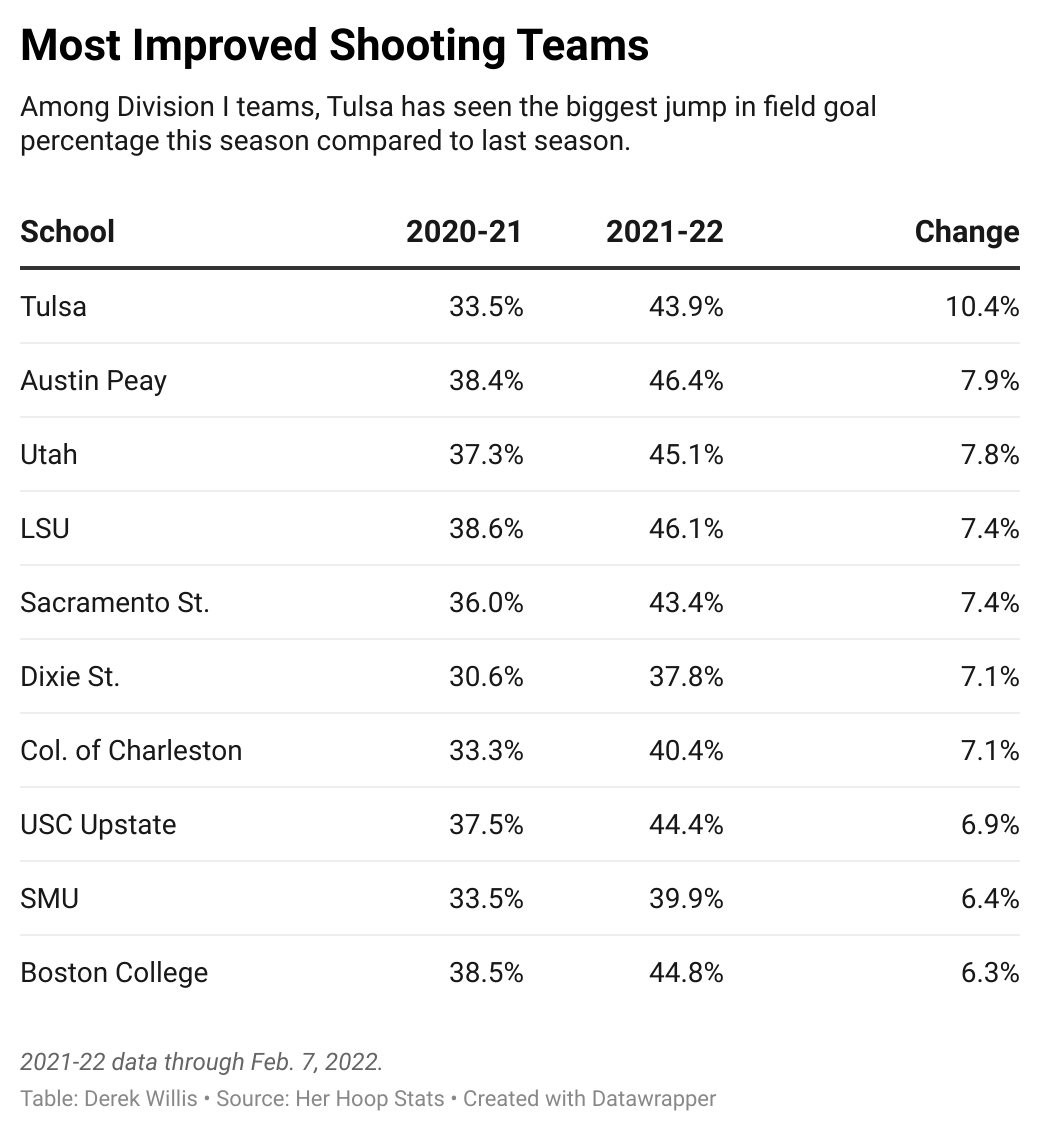‘Don’t turn down shots’: Inside Tulsa’s big shooting improvement
Under first-year coach Angie Nelp, the Golden Hurricane has the largest increase in field goal percentage of any Division I team.
Thanks for reading the Her Hoop Stats Newsletter. If you like our work, be sure to check out our stats site, our podcast, and our social media accounts on Twitter, YouTube, Facebook, and Instagram. You can also buy Her Hoop Stats gear, such as laptop stickers, mugs, and shirts!
Haven’t subscribed to the Her Hoop Stats Newsletter yet?
When Angie Nelp was hired as the coach at Tulsa last year, she inherited a team that made just 33.5% of its shots in the previous season. While there were long-range threats on the roster, Tulsa’s two-point field goal percentage ranked in the bottom fourth percentile among Division I teams.
Watching game film of her new team, “I could see the shots we were getting,” she said in a telephone interview. In response, she put in place a practice process that simulates game conditions but also offers players the chance to expand their abilities by practicing shots without a defender looming.
“Last summer, we decided that there were two areas for improvement: field goal percentage and rebounding,” she said. There wasn’t an issue with who was shooting the ball: “We had a lot of talent.”
This season, with a roster featuring many of the same players, the Golden Hurricane now ranks in the 87th percentile in field goal percentage. As a team, Tulsa is making nearly 44% of its shots, the biggest improvement of any Division I team compared to a season ago.
What happened?
For those expecting some sort of magic formula, Nelp only offers a straightforward explanation. What she needed to do after becoming coach, she said, was to give her players room to grow in practice and stress paying attention to the small things. Nothing revolutionary, even if the results have been (I previously highlighted Tulsa’s success from 3-point range).
“It kind of started in practice,” said junior Maya Mayberry, who is making 44.8% of her attempts this season compared to 37.7% a year ago. “If you practice hard it makes the games easier. We want to be taking game-like shots in practice.”
That doesn’t necessarily mean slowing things down either in practice or games. Tulsa’s offense relies on regular movement around the perimeter and sharp cuts towards the basket. Pushing the tempo in transition often leads to open shots on the wings, and all of the usual starters for the Golden Hurricane have the license to shoot from distance.
“We want shots in rhythm,” Nelp said. “We tell shooters like Maya: ‘Don’t turn down shots.’ We want them to be confident, to shoot in rhythm.”

The result has been improvements nearly across the board among returning players. Mayberry’s field goal percentage has gone from 37.7% to 42.9%. Guard Maddie Bittle’s jump has been even greater, from 37.7% to 48.9%. Rebecca Lescay’s percentage has risen from 38.3% to 44.7%. And Tulsa currently is 13-5, a year after finishing 5-14.
Even when the shots aren’t falling - two days after I spoke to Nelp and Mayberry, Tulsa had one of its poorer shooting performances this season in a 65-58 win over Wichita State - you can see how things are supposed to work. Tulsa went 10 of 39 from three-point range against the Shockers, but many of those misses were open shots within the flow of the offense. Even though Wichita State employed an effective 1-3-1 zone to try and disrupt the offensive movement, Tulsa managed to reverse the ball and rebound on the weak side to produce points.
“We try to make it our mission not to be one-dimensional scorers,” Mayberry said. “The threes come from when my teammates set me up.”
She is joined on the team by her younger sister, Wyvette, who has hit 48% of her three-point attempts this season, the best percentage on the team. They are the daughters of former NBA guard Lee Mayberry, who starred at Arkansas in college.
Tulsa’s shooting improvement hasn’t gone unnoticed by its opponents. Teams beyond just Wichita State have sought to limit the number of three-point looks. “People have been pushing us off the line a bit more,” Nelp said.
The presence of freshman Temira Poindexter, a 6-1 forward who has started the last 12 games, has helped diversify Tulsa’s offense. Although she can shoot the three, Poindexter also is the team’s top offensive rebounder and scored 22 points and nine rebounds against Wichita State.
As much as Tulsa fans have seen the improvement, Nelp says that the coaching staff isn’t overly focused on the numbers when talking to their players. “We don’t really talk a lot about makes, numbers,” she said. “Just the feeling you need to get to be confident to make the shot. You believe in the process and you focus on the process. For us, ‘surrender the outcome’ means doing the best that we can do and the results will take care of themselves. It’s fun to see our players celebrate each other when they make plays.”
Thanks for reading the Her Hoop Stats Newsletter. If you like our work, be sure to check out our stats site, our podcast, and our social media accounts on Twitter, YouTube, Facebook, and Instagram.




